Abstract
Renal impairment is frequent in patients with multiple myeloma and is correlated with an inferior prognosis. This analysis evaluates the prognostic role of renal impairment in patients with myeloma treated with bortezomib before and after autologous stem cell transplantation within a prospective randomized phase III trial. Eight hundred and twenty-seven newly diagnosed myeloma patients in the HOVON-65/GMMG-HD4 trial were randomized to receive three cycles of vincristine, adriamycin, dexamethasone (VAD) or bortezomib, adriamycin, dexamethasone (PAD) followed by autologous stem cell transplantation and maintenance with thalidomide 50 mg daily (VAD-arm) or bortezomib 1.3 mg/m2 every 2 weeks (PAD-arm). Baseline serum creatinine was less than 2 mg/dL (Durie-Salmon-stage A) in 746 patients and 2 mg/dL or higher (stage B) in 81. In myeloma patients with a baseline creatinine ≥2 mg/dL the renal response rate was 63% in the VAD-arm and 81% in the PAD-arm (P=0.31). The overall myeloma response rate was 64% in the VAD-arm versus 89% in the PAD-arm with 13% complete responses in the VAD-arm versus 36% in the PAD-arm (P=0.01). Overall survival at 3 years for patients with a baseline creatinine ≥2 mg/dL was 34% in the VAD-arm versus 74% in the PAD-arm (P<0.001) with a progression-free survival rate at 3 years of 16% in the VAD-arm versus 48% in the PAD-arm (P=0.004). Overall and progression-free survival rates in the PAD-arm were similar in patients with a baseline creatinine ≥2 mg/dL or <2 mg/dL. We conclude that a bortezomib-containing treatment before and after autologous stem cell transplantation overcomes the negative prognostic impact of renal impairment in patients with newly diagnosed multiple myeloma. The trial was registered at www.trialregister.nl as NTR213 and at www.controlled-trials.com as ISRCTN 64455289
Introduction
Renal impairment (RI) affects up to 50% of patients with multiple myeloma (MM).1,2 A serum creatinine ≥2 mg/dL (177 μmol/L) at diagnosis is a well-known risk factor for inferior survival in the Durie and Salmon staging system.3 This is also reflected in the International Staging System (ISS)4 since serum beta-2-microglobulin is correlated not only with tumor burden but also with renal function.
Bortezomib is administered without dose reductions to myeloma patients with RI.5 In relapsed/refractory myeloma patients with a creatinine clearance <50 mL/min it has been shown to improve responses, progression-free survival (PFS) and overall survival (OS).6 Combined with chemotherapy it reverted light-chain-induced RI in 62% of patients.7 A subgroup analysis of the VISTA trial8 in transplant-ineligible myeloma patients found comparable efficacy in patients with or without moderate RI in the bortezomib-melphalan-pred-nisone arm but patients with creatinine >2 mg/dL were excluded. A recent single-center study9 suggested that RI is no longer a negative prognostic factor when thalidomide, lenalidomide or bortezomib are used as part of first-line therapy. However, the study was retrospective, had no control group and less than 10% of patients had undergone autologous stem cell transplantation (ASCT). So far there are no prospective data from controlled phase III trials regarding the impact of novel agents such as bortezomib on the outcome of first-line treatment in newly diagnosed, transplant-eligible myeloma patients with RI.
The prospective, randomized phase III HOVON-65/GMMG-HD4 trial included patients with RI and investigated a bortezomib-containing regimen as part of a high-dose therapy strategy. While the general results of the study have recently been published,10 we report here on a planned subgroup analysis focusing on the outcome of patients with a baseline serum creatinine ≥2 mg/dL (Durie-Salmon stage B).
Methods
Patients
Eight hundred and thirty-three patients with newly diagnosed symptomatic MM Durie and Salmon stage II or III aged between 18 and 65 years and with adequate performance status were included in a prospective clinical study of the HOVON in the Netherlands and Belgium and the GMMG in Germany. Key exclusion criteria included the presence of systemic AL amyloidosis, non-secretory MM, neuropathy grade 2 or higher, a history of active malignancy during the past 5 years, positivity for human immunodeficiency virus, or hepatic dysfunction. Patients could be included regardless of their renal function including dialysis dependence. A total of 827 eligible patients were available for analysis.
The study was approved by the Ethics Committees of the Erasmus Medical Center and University, Rotterdam and of the University of Heidelberg, and by the local Ethics Committees of the participating German institutions. All patients gave written informed consent and the trial was conducted according to the European Clinical Trial Directive 2005 and the Declaration of Helsinki concerning human rights.
Renal function
Renal function was assessed by serum creatinine level at study baseline (BLC) and classified using a cut-off BLC of 2 mg/dL, according to stage “A” or “B” of the Durie and Salmon classification.3 Creatinine clearance was calculated with the formula of Cockcroft-Gault. Renal response was defined as complete, partial or minor (CRrenal, PRrenal or MRrenal, respectively) according to the criteria formulated by the International Myeloma Working Group (IMWG).11 Briefly CRrenal is defined as an increase in creatinine clearance from <50 to 60 mL/min or better, a PRrenal is an increase from <15 to 30–59 mL/min and a MRrenal is an increase from <15 to 15–29 mL/min or from 15–29 to 30–59 mL/min.
Study design and treatment
The study design and treatment protocol have been described elsewhere.10 Briefly, patients were randomized 1:1 to vincristine, doxorubicin and dexamethasone (VAD) induction therapy, intensification with high-dose melphalan and ASCT, followed by maintenance therapy with thalidomide 50 mg daily (VAD-arm); or induction with bortezomib, doxorubicin and dexamethasone (PAD),12 high-dose melphalan/ASCT, followed by maintenance with bortezomib 1.3 mg/m2 i.v. two-weekly for 2 years (PAD-arm). High-dose melphalan was given at a dose of 200 mg/m2 or 100 mg/m2 in patients with a creatinine clearance <40 mL/min.
Statistical analysis
All analyses were performed according to the intention-to-treat principle. Response rates between subgroups were compared using a chi-squared test.
PFS and OS were estimated by the Kaplan-Meier method. Survival endpoints were analyzed using Cox regression analysis to evaluate the impact of treatment arm and creatinine level. Hazard ratios (HR) and corresponding 95% confidence intervals (95% CI) were determined. Kaplan-Meier curves for PFS and OS for each of four groups based on treatment arm and baseline creatinine were generated to illustrate survival, and were compared using the logrank test.
The data cut-off date for this report was April 12, 2011. The median follow up of the 588 patients still alive was 41 months (maximum, 66 months). All reported P values are two-sided and have not been adjusted for multiple testing.
Results
Of 827 eligible patients 746 (90%) had a BLC <2 mg/dL and 81 (10%) had a BLC ≥2 mg/dL. The median creatinine serum level in the latter group was 3.33 mg/dL (range, 2.00–18.3) with a calculated median creatinine clearance of 26 mL/min (range, 7 – 49). The median BLC was 1.00 mg/dL (range, 0.35–18.3) in the VAD-arm and 0.96 mg/dL (range, 0.01–8.99) in the PAD-arm. Forty-five patients in the VAD-arm (11%) and 36 patients (9%) in the PAD-arm had a BLC ≥2 mg/dL. The distribution of the baseline characteristics according to BLC and study arm is presented in Table 1. The proportions of both ISS stage III and high-risk genetic features such as del17p or t(4;14) were significantly higher in the subgroup of patients with BLC ≥2 mg/dL
Table 1.
Baseline characteristics according to baseline serum creatinine and study arm.
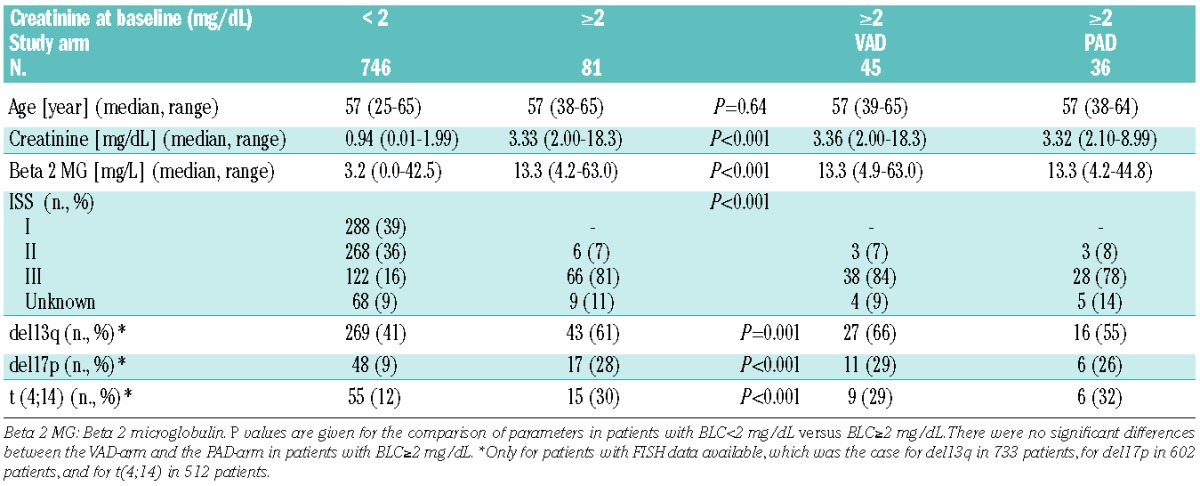
Treatment and toxicity
Of 81 patients with BLC ≥2 mg/dL, 80 received at least one cycle of induction treatment and 63 completed all three cycles. In the VAD-arm 12 patients did not complete induction treatment (reasons given: early death in 4 patients, pneumonia in 2, disease progression in 2, renal failure in 2, aspergillosis in 1 and sepsis in 1) compared to six patients in the PAD-arm (reasons given: early death in 2, pulmonary insufficiency in 1, cardiac failure in 2 and poor performance status in 1). When comparing the rate of adverse events between patients with or without BLC ≥2 mg/dL the safety profile appeared to be comparable except for greater hematologic toxicity during induction for patients with elevated BLC. The distribution of adverse events during the first cycle of induction according to baseline renal function is shown in Figure 1A. Within the patients with BLC ≥2 mg/dL there were no significant differences in the frequency and type of adverse events between the VAD-arm and the PAD-arm (all CTC grade 2: 30 % versus 39%, grade 3: 32% versus 31%, grade 4: 14% versus 19%).
Figure 1A.
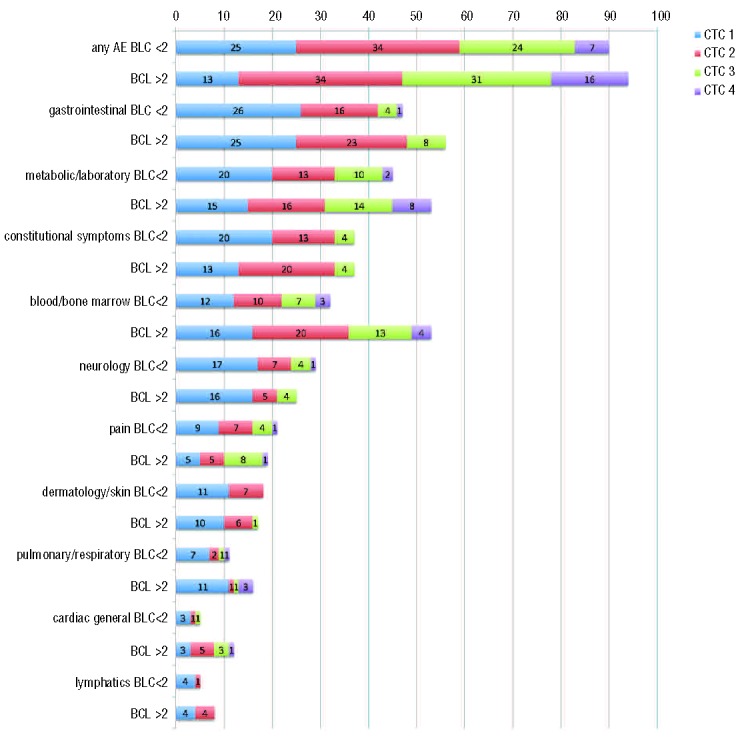
Percentages of adverse events (AE) during induction therapy cycle 1 according to baseline creatinine (<2 mg/dL or ≥2 mg/dL) and CTCAE grades 1–4 (CTCAE version 3.0).
Of 81 patients with BLC ≥2 mg/dL, 57 (70%) received high-dose melphalan, which was given at the full dose of 200 mg/m2 to 39 patients, at 140 mg/m2 to 1 patient and at 100 mg/m2 in 17 patients while 24 patients did not proceed to high-dose therapy. Of the 57 patients receiving high-dose melphalan, 29 were treated in the VAD-arm and 28 in the PAD-arm. The distribution of adverse events during the first course of high-dose therapy seemed to be comparable in patients with BLC ≥2 mg/dL and in those with BLC <2 mg/dL, as illustrated in Figure 1B. Twenty-eight patients in the GMMG received a second ASCT with either 200 mg/m2 (n=18) or 100 mg/m2 (n=10) of melphalan with dose reduction in 6/14 (43%) in the VAD-arm and 4/14 (29%) in the PAD-arm. This difference was not statistically significant (P=0.70). After high-dose therapy 42 of 57 patients (74%) started maintenance treatment, 20 with thalidomide in the VAD-arm and 22 with bortezomib in the PAD-arm.
Figure 1B.
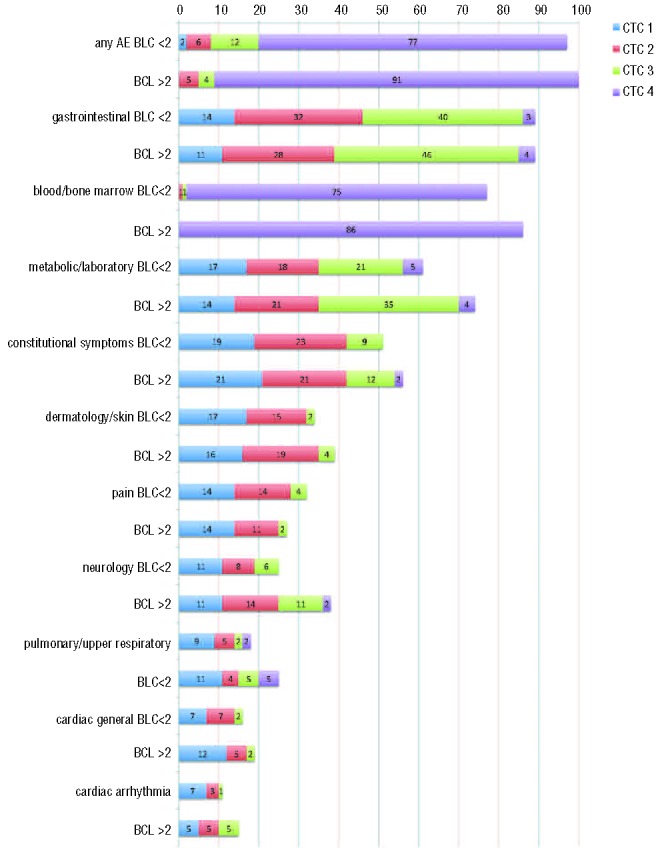
Percentages of events (AE) during first high-dose therapy according to baseline creatinine (<2 mg/dL or ≥2 mg/dL) and CTCAE grades 1–4 (CTCAE version 3.0)
During the course of the study serious adverse events were reported in 62% of patients with BLC <2 mg/dL versus 81% with BLC ≥2 mg/dL. The most frequent reason for classifying an adverse event as serious was hospitalization in 74% in both subgroups. Serious adverse events were judged by the investigators as definitely or probably related to the study treatment in 34% of patients with BLC <2 mg/dL versus 37% with BLC ≥2 mg/dL. The types of serious adverse events were comparable in the two subgroups and are listed in Table 2.
Table 2.
Numbers of serious adverse events according to baseline creatinine (with possibly multiple serious adverse events per patient).
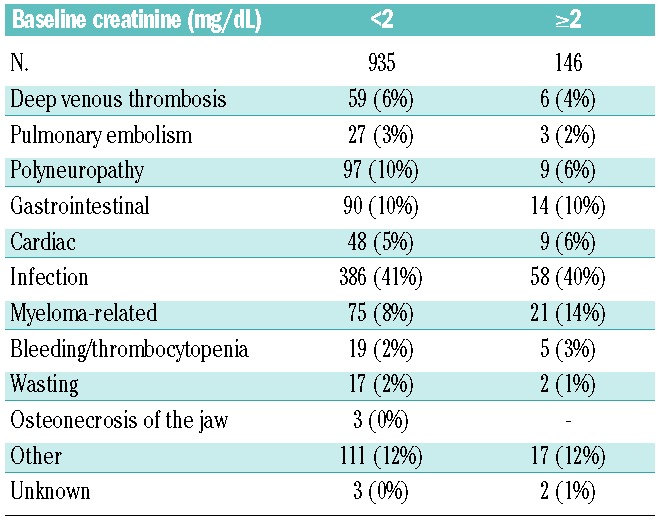
Renal response
Of 81 patients with BLC ≥2 mg/dL, 60 were evaluable for renal response before high-dose therapy. All had a calculated creatinine clearance <50 mL/min at baseline. Using the criteria proposed by the IMWG,11 28 (47%) patients achieved a CRrenal, 1 a PRrenal, 10 (12%) a MRrenal and 21 (26%) had no response. Forty-three patients (71%) regained a creatinine level <2 mg/dL on study treatment. In the 57 patients proceeding to high-dose therapy the median creatinine level was 1.14 mg/dL (range, 0.60 – 6.9) before the high-dose therapy with 38 patients (67%) reaching a level <2 mg/dL. Before high-dose therapy there was no significant difference in renal function between the two treatment arms, with a median creatinine level of 1.41 mg/dL (range, 0.65–6.9) in the VAD-arm and 1.10 mg/dL (range, 0.60–5.9) in the PAD-arm (P=0.43) and a median creatinine clearance of 51 mL/min (range, 12–147) in the VAD-arm versus 65 mL/min (range, 11–180) in the PAD-arm (P=0.42). As far as concerns renal responses, after three cycles of induction treatment, in the VAD-arm 13 (43%) patients were in CRrenal, 1 (3%) patient was in PRrenal and 5 (17%) patients had a MRrenal (overall renal response rate, 63%) whereas in the PAD-arm, 18 (58%) patients had a CRrenal and 7 (23%) had a MRrenal (overall renal response rate, 81%) with no significant difference between the two arms (P=0.31).
Myeloma response
The overall response rate (at least PR) after induction was 68% in patients with BLC <2 mg/dL compared to 49% for those with BLC ≥2 mg/dL (P=0.001, Figure 2). Over the duration of the trial treatment the rate of patients achieving at least a PR was 88% for those with a BLC <2 mg/dL and 74% for those with a BLC ≥2 mg/dL (P<0.001, Figure 2). In the subgroup of 81 patients with BLC ≥2 mg/dL, there were significant differences in response depending on the treatment arm (Figure 3): after one to three cycles of induction treatment the overall response rate in the bortezomib-containing PAD-arm was 75%, with 33% of patients achieving at least a very good PR, compared to 36% and 9% in the VAD-arm (P=0.003), respectively. This difference remained detectable when considering the best response achieved any time during trial treatment (89% versus 64%, P=0.01), mainly due to a higher CR rate of 36% in the PAD-arm compared to 13% in the VAD-arm.
Figure 2.
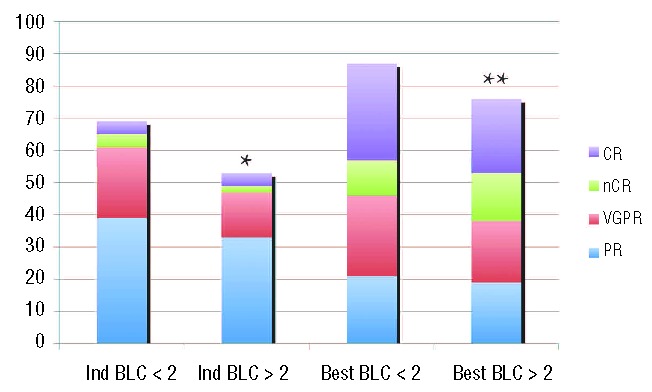
Myeloma response according to baseline creatinine (intent-to-treat). BLC: baseline creatinine, Ind: response after induction treatment, Best: best response achieved any time on study treatment. BLC <2 mg/dL: n=746, BLC≥2 mg/dL: n=81. *P=0.001 compared to BLC <2 mg/dL; **P<0.001 compared to BLC <2 mg/dL.
Figure 3.
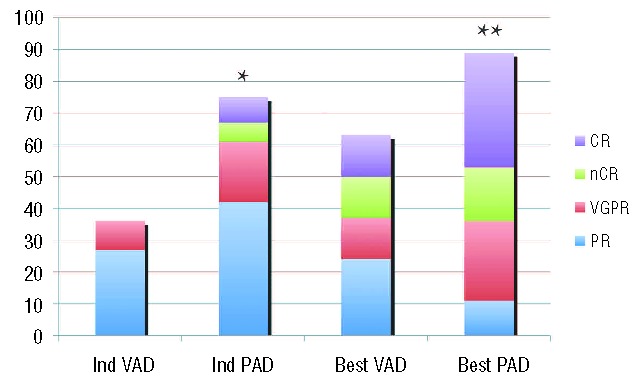
Response in the subgroup of 81 patients with BLC ≥2 mg/dL according to treatment arm (intent-to-treat). BLC: baseline creatinine, Ind=response after induction treatment, Best: best response achieved any time on study treatment. VAD-arm: n=45, PAD-arm: n=36. *P=0.003 compared to VAD-arm; **P=0.01 compared to VAD-arm.
Progression-free and overall survival
The PFS rate was 30% at 3 years and 20% at 5 years for patients with BLC ≥2 mg/dL and 46% and 26%, respectively with BLC <2 mg/dL, (P<0.001). Treatment in the PAD-arm led to a marked improvement in PFS rate from 16% to 48% at 3 years in patients with a BLC ≥2 mg/dL (P=0.004) and in patients with BLC <2 mg/dL, respectively (3-year PFS was 43% in the VAD-arm versus 48% in the PAD-arm; P=0.023). The Kaplan-Meier survival curves for PFS for all four groups are shown in Figure 4A.
Figure 4.

Progression-free survival (A) and overall survival (B) according to baseline creatinine (BLC) and treatment arm. PAD: bortezomib for induction and maintenance, VAD=VAD for induction and thalidomide for maintenance.
The OS rate was significantly inferior in patients presenting with a BLC ≥2 mg/dL, being 51% at 3 years and 33% at 5 years versus 78% (at 3 years) and 61% (at 5 years) in patients with a BLC <2 mg/dL (P<0.001). The OS rate at 3 years for patients with a BLC ≥2 mg/dL was significantly higher in patients treated in the PAD-arm (74%) than in those in the VAD-arm (34%, HR = 0.33, 95% CI = 0.16–0.65, P<0.001), while the OS was similar in both arms in patients with BLC <2 mg/dL.
Within the PAD-arm OS at 3 years was very similar in patients with BLC <2 mg/dL (79%) and those with BLC ≥2 mg/dL (74%, HR = 0.94, 95% CI = 0.71–1.25; P=0.68). The Kaplan-Meier survival curves for OS for all four groups are shown in Figure 4B.
Discussion
Although RI is frequent in newly diagnosed MM, many study protocols8,13–15 use thresholds for renal function in their inclusion criteria, leading to an underrepresentation of such high-risk patients in the study cohorts. Since the HOVON-65/GMMG-HD4 included patients regardless of renal function we were able to analyze the feasibility and efficacy of a bortezomib-based treatment before and after ASCT in patients with RI based on data from a prospective randomized study.
During induction patients with BLC ≥2 mg/dL showed a comparable profile of adverse events as those with BLC <2 mg/dL except for increased hematologic toxicity. The frequency and distribution of serious adverse events were not significantly different between the two subgroups indicating that the treatment protocol was feasible in a large multicenter trial including patients with RI up to the age of 65 years.
Both induction regimens with VAD or PAD led to a reduction of the serum creatinine level to less than 2 mg/dL in the majority of patients and 70% of patients with a BLC ≥2 mg/dL actually proceeded to high-dose therapy with full-dose melphalan, in most cases with no differences between both arms. The treatment-related mortality after ASCT could be limited to 2%, which compares favorably to previously published results in patients with RI.16–21 There was no difference in frequency or duration of maintenance treatment with either thalidomide (VAD-arm) or bortezomib (PAD-arm).
The rates of renal recovery in the bortezomib-containing PAD-arm (55% CRrenal and 21% MRrenal with an overall renal response rate of 76%) compare favorably with those previously obtained with PAD and reported by Ludwig et al.:7 31% CRrenal, 7% PRrenal and 24% MRrenal. Although we could not demonstrate a significant difference in renal response between the study arms, there was a trend for all analyzed renal parameters to be better in the PAD-arm than in the VAD-arm. In view of the limited number of patients in this subgroup analysis we cannot exclude that the absence of significant differences in renal response may be due to a lack of statistical power.
There was a significant improvement in myeloma response with an overall response rate (≥PR) of 75% after three cycles of PAD versus 36% after three cycles of VAD. In the French IFM 2005-01 study comparing bortezomib + dexamethasone versus VAD as induction regimen,15 there was also a higher overall response rate for the bortezomib regimen (79% versus 63%). Although no analysis regarding renal function was reported, the difference within the ISS stage 3 cohort was more pronounced (77% versus 57%). However this benefit in response did not translate into an improved PFS or OS. This difference from our results may be due to the addition of doxorubicin in the induction regimen and/or the use of maintenance with bortezomib in the PAD-arm of our protocol. In the French study lenalidomide or no maintenance treatment was given, since the majority of patients were subsequently included in a maintenance trial (IFM 2005-02). With very comparable overall response rates to induction the addition of doxorubicin is unlikely to be the reason for the improvement in survival in our study in comparison to the IFM 2005-01 trial. It does, therefore, appear that patients with high-risk myeloma, as defined by their having RI, may derive particular benefit from bortezomib when it is used not only for induction but also for maintenance after ASCT. Two recent studies22,23 have shown improved PFS with lenalidomide maintenance after ASCT. Both study protocols excluded patients with a serum creatinine ≥2 mg/dL; however, in view of the high renal response after induction found in our study, maintenance with lenalidomide after ASCT may also be a future option for patients presenting with renal failure at diagnosis.
Since FISH results were available for most patients, our results indicate for the first time that patients with RI have an increased frequency of adverse genetic features such as del17p or t(4;14). We previously demonstrated in the HOVON65/GMMG HD4 study24 that patients with these adverse factors benefit from the combination of bortezomib and high-dose therapy. Still, only a third of the patients with a BLC ≥2 mg/dL had del17p or t(4;14). Vice versa only about 25% of patients with del17p or t(4;14) also had a serum creatinine ≥2 mg/dL. Thus there was only a partial overlap between both types of high-risk myeloma and the higher rate of adverse genetic features in the cohort of patients with BLC ≥2 mg/dL found in our study is certainly not sufficient to explain the worse prognosis in myeloma patients with RI. This is supported by a recent analysis from the MRC Myeloma IX study25 which also included patients undergoing ASCT: ISS stage (reflecting in part renal function as explained earlier) and genetic risk factors such as del17p or changes involving chromosome 14 were found to be independent predictors of both OS and PFS.
We confirmed the negative prognostic impact of RI in the VAD-arm of our study, finding a 3-year OS rate of only 34% in patients with BLC ≥2 mg/dL compared to 76% in those with BLC <2 mg/dL. In contrast there was no effect of RI on OS or PFS in the PAD-arm, implying that the integration of bortezomib into a high-dose treatment protocol appears to abrogate the negative prognostic impact of RI in newly diagnosed myeloma patients. Retrospective cohort studies9,26 have suggested that the use of novel agents in the frontline treatment of MM patients with RI have improved results in a way that RI may no longer have a negative prognostic impact,27,28 in particular when using modern three-drug regimens.29 The high rates of myeloma and renal response, in particular to bortezomib, in patients with moderate RI in two prospective trials8,30 have further supported this view. However both trials excluded patients with markedly elevated creatinine.
This subgroup analysis of a large randomized phase III study in newly diagnosed MM patients demonstrates for the first time in a prospective trial that the negative impact of RI, as classified by Durie-Salmon stage “B”, can be overcome by incorporating bortezomib both before and after ASCT. The addition of bortezomib to a high-dose regimen should, therefore, be considered as a standard of care in otherwise transplant-eligible MM patients presenting with RI.
Supplementary Material
Acknowledgments
The authors would like to thank Steffen Luntz and Baerbel Schurich from the Coordination Center for Clinical Trials at the University of Heidelberg for their continuous support in the trial conduct.
Footnotes
The online version of this article has a Supplementary Appendix.
Funding
This trial was supported by the Dutch Cancer Foundation, the German Federal Ministry of Education and Research and an unrestricted grant from Janssen-Cilag. The GMMG study group received further grants to support this trial from Novartis, Amgen, Chugai and Roche.
Authorship and Disclosures
Information on authorship, contributions, and financial & other disclosures was provided by the authors and is available with the online version of this article at www.haematologica.org.
References
- 1.Dimopoulos MA, Terpos E. Renal insufficiency and failure Hematology Am Soc Hematol Educ Program. 2010:431–6 [DOI] [PubMed] [Google Scholar]
- 2.Knudsen LM, Hippe E, Hjorth M, Holmberg E, Westin J. Renal function in newly diagnosed multiple myeloma–a demographic study of 1353 patients. The Nordic Myeloma Study Group. Eur J Haematol. 1994;53(4):207–12 [DOI] [PubMed] [Google Scholar]
- 3.Salmon SE, Durie BG. Cellular kinetics in multiple myeloma. A new approach to staging and treatment. Arch Intern Med. 1975;135(1):131–8 [PubMed] [Google Scholar]
- 4.Greipp PR, San Miguel J, Durie BGM, Crowley J, Barlogie B, Blade J, et al. International Staging System for multiple myeloma. J Clin Oncol. 2005;23(15):3412–20 [DOI] [PubMed] [Google Scholar]
- 5.Jagannath S, Barlogie B, Berenson JR, Singhal S, Alexanian R, Srkalovic G, et al. Bortezomib in recurrent and/or refractory multiple myeloma. Cancer. 2005;103(6):1195–200 [DOI] [PubMed] [Google Scholar]
- 6.San-Miguel JF, Richardson PG, Sonneveld P, Schuster MW, Irwin D, Stadtmauer EA, et al. Efficacy and safety of bortezomib in patients with renal impairment: results from the APEX phase 3 study. Leukemia. 2008;22(4):842–9 [DOI] [PubMed] [Google Scholar]
- 7.Ludwig H, Adam Z, Hajek R, Greil R, Tothova E, Keil F, et al. Light chain-induced acute renal failure can be reversed by bortezomib-doxorubicin-dexamethasone in multiple myeloma: results of a phase II study. J Clin Oncol. 2010;28(30):4635–41 [DOI] [PubMed] [Google Scholar]
- 8.Dimopoulos MA, Richardson PG, Schlag R, Khuageva NK, Shpilberg O, Kastritis E, et al. VMP (bortezomib, melphalan, and prednisone) is active and well tolerated in newly diagnosed patients with multiple myeloma with moderately impaired renal function, and results in reversal of renal impairment: cohort analysis of the phase III VISTA study. J Clin Oncol. 2009;27(36):6086–93 [DOI] [PubMed] [Google Scholar]
- 9.Eleftherakis-Papapiakovou E, Kastritis E, Roussou M, Gkotzamanidou M, Grapsa I, Psimenou E, et al. Renal impairment is not an independent adverse prognostic factor in patients with multiple myeloma treated upfront with novel agent-based regimens. Leuk Lymphoma. 2011;52(12):2299–303 [DOI] [PubMed] [Google Scholar]
- 10.Sonneveld P, Schmidt-Wolf IG, van der Holt B, El Jarari L, Bertsch U, Salwender H, et al. Bortezomib induction and maintenance treatment in patients with newly diagnosed multiple myeloma: results of the randomized phase III HOVON-65/ GMMG-HD4 trial. J Clin Oncol. 2012;30 (24):2946–55 [DOI] [PubMed] [Google Scholar]
- 11.Dimopoulos MA, Terpos E, Chanan-Khan A, Leung N, Ludwig H, Jagannath S, et al. Renal impairment in patients with multiple myeloma: a consensus statement on behalf of the International Myeloma Working Group. J Clin Oncol. 2010;28(33):4976–84 [DOI] [PubMed] [Google Scholar]
- 12.Oakervee HE, Popat R, Curry N, Smith P, Morris C, Drake M, et al. PAD combination therapy (PS-341/bortezomib, doxorubicin and dexamethasone) for previously untreated patients with multiple myeloma. Br J Haematol. 2005;129(6):755–62 [DOI] [PubMed] [Google Scholar]
- 13.Mateos M-V, Richardson PG, Schlag R, Khuageva NK, Dimopoulos MA, Shpilberg O, et al. Bortezomib plus melphalan and prednisone compared with melphalan and prednisone in previously untreated multiple myeloma: updated follow-up and impact of subsequent therapy in the phase III VISTA trial. J Clin Oncol. 2010;28(13):2259–66 [DOI] [PubMed] [Google Scholar]
- 14.Facon T, Mary JY, Hulin C, Benboubker L, Attal M, Pegourie B, et al. Melphalan and prednisone plus thalidomide versus melphalan and prednisone alone or reduced-intensity autologous stem cell transplantation in elderly patients with multiple myeloma (IFM 99-06): a randomised trial. Lancet. 2007;370(9594):1209–18 [DOI] [PubMed] [Google Scholar]
- 15.Harousseau JL, Attal M, Avet-Loiseau H, Marit G, Caillot D, Mohty M, et al. Bortezomib plus dexamethasone is superior to vincristine plus doxorubicin plus dexamethasone as induction treatment prior to autologous stem-cell transplantation in newly diagnosed multiple myeloma: results of the IFM 2005-01 phase III trial. J Clin Oncol. 2010;28(30):4621–9 [DOI] [PubMed] [Google Scholar]
- 16.Badros A, Barlogie B, Siegel E, Roberts J, Langmaid C, Zangari M, et al. Results of autologous stem cell transplant in multiple myeloma patients with renal failure. Br J Haematol. 2001;114(4):822–9 [DOI] [PubMed] [Google Scholar]
- 17.San Miguel JF, Lahuerta JJ, Garcia-Sanz R, Alegre A, Blade J, Martinez R, et al. Are myeloma patients with renal failure candidates for autologous stem cell transplantation¿ Hematol J. 2000;1(1):28–36 [DOI] [PubMed] [Google Scholar]
- 18.Parikh GC, Amjad AI, Saliba RM, Kazmi SM, Khan ZU, Lahoti A, et al. Autologous hematopoietic stem cell transplantation may reverse renal failure in patients with multiple myeloma. Biol Blood Marrow Transplant. 2009;15(7):812–6 [DOI] [PMC free article] [PubMed] [Google Scholar]
- 19.Bird JM, Fuge R, Sirohi B, Apperley JF, Hunter A, Snowden J, et al. The clinical outcome and toxicity of high-dose chemotherapy and autologous stem cell transplantation in patients with myeloma or amyloid and severe renal impairment: a British Society of Blood and Marrow Transplantation study. Br J Haematol. 2006;134(4):385–90 [DOI] [PubMed] [Google Scholar]
- 20.Carlson K. Melphalan 200 mg/m2 with blood stem cell support as first-line myeloma therapy: impact of glomerular filtration rate on engraftment, transplantation-related toxicity and survival. Bone Marrow Transplant. 2005;35(10):985–90 [DOI] [PubMed] [Google Scholar]
- 21.Knudsen LM, Nielsen B, Gimsing P, Geisler C. Autologous stem cell transplantation in multiple myeloma: outcome in patients with renal failure. Eur J Haematol. 2005;75(1):27–33 [DOI] [PubMed] [Google Scholar]
- 22.Attal M, Lauwers-Cances V, Marit G, Caillot D, Moreau P, Facon T, et al. Lenalidomide maintenance after stem-cell transplantation for multiple myeloma. N Engl J Med. 2012;366(19):1782–91 [DOI] [PubMed] [Google Scholar]
- 23.McCarthy PL, Owzar K, Hofmeister CC, Hurd DD, Hassoun H, Richardson PG, et al. Lenalidomide after stem-cell transplantation for multiple myeloma. N Engl J Med. 2012;366(19):1770–81 [DOI] [PMC free article] [PubMed] [Google Scholar]
- 24.Neben K, Lokhorst HM, Jauch A, Bertsch U, Hielscher T, van der Holt B, et al. Administration of bortezomib before and after autologous stem cell transplantation improves outcome in multiple myeloma patients with deletion 17p. Blood. 2012;119(4):940–8 [DOI] [PubMed] [Google Scholar]
- 25.Boyd KD, Ross FM, Chiecchio L, Dagrada GP, Konn ZJ, Tapper WJ, et al. A novel prognostic model in myeloma based on co-segregating adverse FISH lesions and the ISS: analysis of patients treated in the MRC Myeloma IX trial. Leukemia. 2012;26(2):349–55 [DOI] [PMC free article] [PubMed] [Google Scholar]
- 26.Dimopoulos MA, Roussou M, Gkotzamanidou M, Nikitas N, Psimenou E, Mparmparoussi D, et al. The role of novel agents on the reversibility of renal impairment in newly diagnosed symptomatic patients with multiple myeloma. Leukemia. 2013;27(2):423–9 [DOI] [PubMed] [Google Scholar]
- 27.Chanan-Khan AA, San Miguel JF, Jagannath S, Ludwig H, Dimopoulos MA. Novel therapeutic agents for the management of patients with multiple myeloma and renal impairment. Clin Cancer Res. 2012;18(8):2145–63 [DOI] [PubMed] [Google Scholar]
- 28.Gaballa MR, Laubach JP, Schlossman RL, Redman K, Noonan K, Mitsiades CS, et al. Management of myeloma-associated renal dysfunction in the era of novel therapies. Expert Rev Hematol. 2012;5(1):51–66; quiz 7–8 [DOI] [PubMed] [Google Scholar]
- 29.Costa LJ, Abbas J, Ortiz-Cruz KL, Kang Y, Stuart RK. Outcomes of patients with multiple myeloma and renal impairment treated with bortezomib, cyclophosphamide, and dexamethasone without plasma exchange. Eur J Haematol. 2012;89(5):432–4 [DOI] [PubMed] [Google Scholar]
- 30.Morabito F, Gentile M, Mazzone C, Rossi D, Di Raimondo F, Bringhen S, et al. Safety and efficacy of bortezomib-melphalan-prednisone-thalidomide followed by bortezomib-thalidomide maintenance (VMPT-VT) versus bortezomib-melphalan-prednisone (VMP) in untreated multiple myeloma patients with renal impairment. Blood. 2011;118 (22):5759–66 [DOI] [PubMed] [Google Scholar]
Associated Data
This section collects any data citations, data availability statements, or supplementary materials included in this article.


